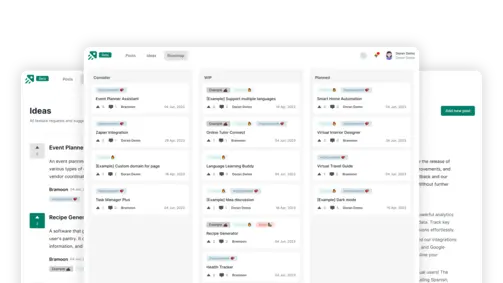How to Build a CSAT Survey: Tips and Best Practices
Create changelog and product roadmap for your product
Explore nowTable of contents 6 min
Customer Satisfaction (CSAT) surveys are essential tools for gauging how happy your customers are with your products or services. Understanding how to build a CSAT survey effectively can provide valuable insights into customer experiences and help you identify areas for improvement. In this article, we’ll guide you through the process of creating a CSAT survey, from designing questions that yield actionable feedback to implementing and analyzing the results. By mastering how to build a CSAT survey, you can enhance customer satisfaction, foster loyalty, and drive business growth.
How to Build a CSAT survey

How to create a customer satisfaction survey? Now, we will examine the necessary steps to assist you in creating, constructing, and implementing surveys that align with your brand and effectively engage your customers, ultimately providing valuable insights.
Select a Survey Tool
First and foremost on how to build a CSAT survey, selecting a user feedback tool is essential. The choice of survey tool is determined by the method of survey distribution. For instance, if you wish to add a more extensive survey to a landing page on a website, you have the option to utilise tools such as Typeform, SurveyMonkey, Google Forms, or other similar solutions. After initiating the process of gathering user feedback, it becomes possible to analyse the obtained data and monitor users based on their unique ID in order to document the evolution of their sentiment over a period of time.
Personalize your Survey to Align with your Brand Identity
Once you’ve selected your preferred tool, the next crucial step in how to build a CSAT survey is to ensure seamless alignment between the survey you’re creating and your brand’s unique style. In order to meet your specific requirements, it will be necessary to have the ability to personalise colours, buttons, sizes, animated effects, and even incorporate custom CSS if necessary.
What is the significance of this? Because if you run a survey that doesn’t look and feel like it’s coming from your company, you risk confusing users and getting only a small percentage of useful responses.
Divide your Users into Distinct Segments
An important consideration when it comes to survey distribution in how to build a CSAT survey is to avoid showing the identical survey to every individual who interacts with your website. This includes visitors, free trial users, customers upgrading their plans, or those who decide to cancel their subscription and leave.
In many of the scenarios mentioned above, a single survey that asks a question like “How satisfied are you with our product?” would be completely out of context.
Individuals who have recently engaged with your product may not possess the necessary knowledge and familiarity to accurately determine their level of satisfaction. Now, it would be helpful to ask “Is everything has been clear so far?”. If the answer is negative, an additional step may be triggered to provide personalised guidance or a link to the self-serve knowledge base.
Alternatively, if a customer is considering cancelling, it’s likely that they were not completely satisfied with your product. In this situation, it would be more suitable to ask, “Could you please share your reason for leaving?”
It is crucial to properly segment your customers. Segmentation can be done based on various variables such as unique user IDs, browsers used, survey steps already taken, in-product tasks and milestones completed, and time of task completion, among others.
Ensure that your Survey is Aligned with its Use Case

Another crucial aspect of how to build a CSAT survey involves precisely outlining the purpose for each survey. It is essential to harmonise the style, format, question type, and your brand’s voice and tone with the ultimate objective.
When determining the use case and goal for your survey, it is important to consider various factors. These include the purpose of your research, the type of data you wish to collect (quantitative or qualitative), the specific customer segment you want to target, the stage of their customer journey, the metrics you want to track, and any other relevant criteria.
Implement a Survey that is Triggered-based
An effective approach on how to build a CSAT survey is to activate them based on a specific event. An event can refer to any task or predefined milestone that is completed by your users.
By following this approach, you will obtain the necessary data to effectively assess the outcomes of various onboarding flow moments, as well as any new features or important updates that you introduce to your product.
Avoid Overwhelming Users
The phenomenon of pop-up fatigue is a genuine concern. To enhance user experience, it is advisable to minimise the number of pop-up screens, modals, tour steps, and surveys that appear consecutively. Instead, focus on displaying only one modal or survey pop-up at a time to prevent user frustration.
By following the steps we previously outlined in how to build a CSAT survey, you can effectively segment your audience, display targeted surveys, and create a streamlined in-product microsurvey that yields valuable feedback.
Customer Satisfaction Survey guide - Notable examples
Google Calendar

This survey for Google Calendar demonstrates a freeform feedback survey that is delivered through a support widget located in the top menu bar. This survey falls into the category of flexible microsurveys, as it does not follow a traditional rating scale format. Google effectively gauges customer satisfaction by proactively asking for feedback and providing a convenient method to share it.
Reasons why this is considered good: Offering users the ability to incorporate a screenshot of their current problem is a valuable addition. The feedback process becomes significantly more streamlined for the user. In addition, copy that is clear and informative is in line with Google’s brand. In general, the survey modal is well-organized and includes a contextual prompt.
Building an effective CSAT survey is a strategic process that can significantly impact your understanding of customer satisfaction. By carefully crafting questions, deploying the survey at the right times, and thoroughly analyzing the results in how to build a CSAT survey, you can gain deep insights into your customers’ experiences. Implementing changes based on this feedback can lead to improved customer satisfaction and retention. Start building your CSAT survey today to harness the power of customer feedback and propel your business forward.
What to not miss out on our blog
Gain insightful knowledge and invaluable experiences from dedicated experts.

CRM System Explained: Benefits, Types, and How It Works
Discover everything about CRM system. Learn the benefits and how a CRM system works to improve customer relationships and streamline business operations.

Are you ready? Start your free trial today.
Enhance communication, keep track of the progress, understand customers' insight and more by taking your first trial on Doran.
Sign up for free

